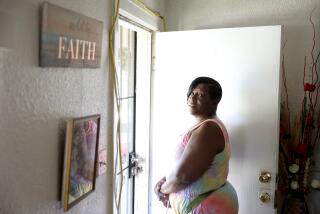USC : Foster-Youth Home Due for a Face Lift
- Share via
When Jenny Serrano turned 18 in September, she was released from the county foster care system to face the world virtually alone.
After an unsuccessful reunion with her parents, whose reported drug use and mistreatment landed her in foster care at 14, Serrano wandered from one friend’s couch to another “basically homeless.”
But in early January, Serrano’s social worker told her about an innovative program that helps former foster youth with the transition to responsible adulthood. Two days later, she was enrolled in Foster Youth Connection and living for free at its group home a stone’s throw from USC’s fraternity row. With two part-time jobs, Serrano hopes to save enough money to move out on her own by the end of the year.
“I’m glad I didn’t slip through the cracks,” said Serrano, one of 12 residents at the 2713 Severance St. facility--formerly a fraternity house. “This place has really helped me. . . . It lets you know you have a place to come home to.”
But while Foster Youth Connection has been successful in helping Serrano and hundreds like her, program staff members have recently had to turn an attentive eye to the deteriorating group home itself.
Built by a family of Southern anti-slavery crusaders in 1890, the three-story wood home has suffered under gradual decay, wild fraternity bashes and earthquakes.
The home, however, is scheduled this month for rehabilitation, in which the original roof, plumbing and wiring will be replaced and fresh paint applied inside and out.
As an official historic landmark, restoration must follow strict preservation guidelines. For example, contractors must use plaster instead of dry-wall to repair gaping holes inside the home, and replacement moldings must match the wood type and intricacy of the originals.
“My concern is we won’t have enough money and expertise to complete” the work, said program coordinator Kasey Bedford.
The price tag for the project has been estimated at $100,000, and executive director Miranda Barone said only half of that amount has been raised.
Still, the group was fortunate to have been selected as the recipient of free restoration work by an area nonprofit organization that helps renovate old homes, schools and community centers.
Roughly 50 volunteers with Christmas In April-South Central Los Angeles are expected to descend on the home during the month to help paint and perform minor repairs.
While preparations for the renovation and fund raising have been a chore, Barone said the effort will have been worth it.
“We want a house that everyone can be absolutely proud of,” Barone said.
Yet program recipients like Serrano are grateful for the house, no matter what its condition.
She credits Foster Youth Connection--one of only a handful of such programs for former foster children countywide--with helping her pursue her goal of becoming a counselor for youngsters with drug-addicted parents.
Through Connection, Serrano has enrolled in classes at Los Angeles City College and landed one of her jobs. “I’m really happy I found (the program),” she said.
Started by a handful of foster youth as a support and advocacy group in 1989, the program provides counseling, case management, education and job opportunities for group-home residents and more than 200 other former foster youth living elsewhere. The organization operates on a yearly budget of $130,000 financed through public agencies, foundation grants and private donations.
All youth involved in the program are given help in finding jobs and continuing their education, and those who live at the house are required to save enough money to move out on their own after two years. All participants are also offered “how-to” workshops in such areas as budgeting, hygiene and job interviewing.
Peter Digre, director of the county’s Department of Children and Family Services, called programs like Foster Youth Connection “absolutely essential” for the estimated 1,000 18-year-olds released from the system every year.
“They just can’t go out and jump-start their lives” without help, he said. “If they slip up for one moment they end up on the streets.”
More to Read
Sign up for Essential California
The most important California stories and recommendations in your inbox every morning.
You may occasionally receive promotional content from the Los Angeles Times.










